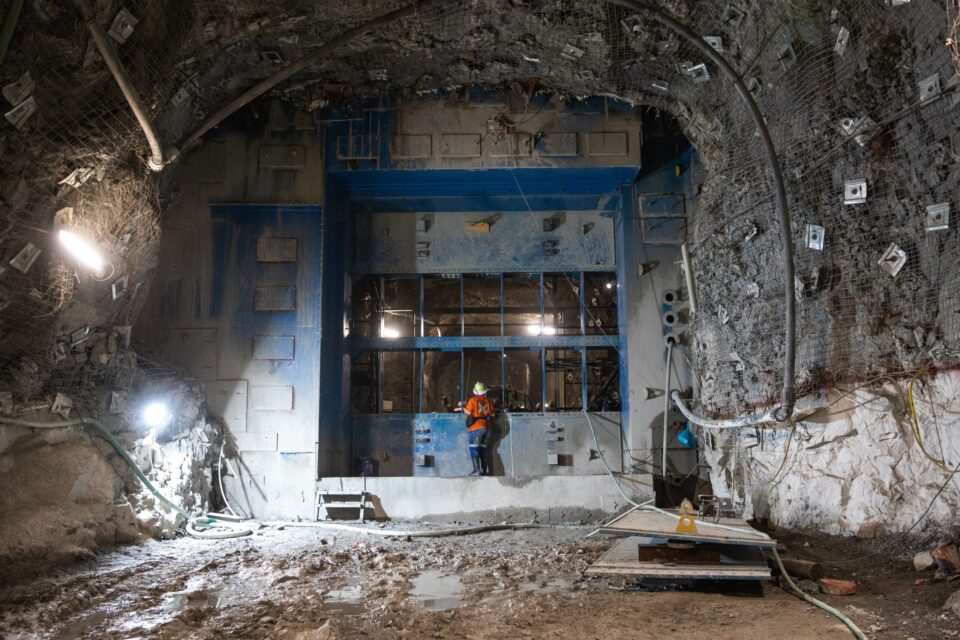An important milestone in the development of the US$2 billion De Beers Venetia Underground Project (VUP) has been reached with the completion of the first of six water control doors which are designed to counter water ingress into the underground mine. The doors have to be completed in advance of first production from the VUP, expected in H1-2023.
The first water control door is a huge structure, with the steel frame some 8 m high, 8 m wide and 1 m thick. It is designed to hold back a 100 m head of water. Its construction has been undertaken by leading underground mining contractor Murray & Roberts Cementation, whose scope of work includes a further three doors. Construction of the second door has recently started.
The need for the water control doors arises from the fact that the new underground mine, a large-scale caving operation, is being developed directly beneath the current open pit. At times of heavy rainfall, the pit will act as a giant funnel, potentially allowing large volumes of water to penetrate the underground workings. Although the Venetia mine is located to the west of Musina in Limpopo Province in an area generally regarded as hot and dry, heavy rains can occur in the summer months.
The water control doors will be activated in the event of water inflows into the mine exceeding the capacity of the underground pumping system, which will ultimately have the ability to pump 4 500 m3/h out of the mine. They are designed to seal off the ‘dry’ side of the mine, where the water pumps and other critical infrastructure are located, from the ‘wet’ side, where mining operations on the kimberlite pipe take place.
According to Jacques Labuschagne, Murray & Robert Cementation’s Contracts Manager for the construction of underground works at the VUP, the construction of the water control doors is not a run-of-the-mill assignment for the company.
“This is not a ‘first’ for Murray & Robert Cementation but certainly the sheer size of these doors is unusual,” he says. Labuschagne and his team were handed over the site for the construction of the first door – the first of two on 46 level – late in 2021. “Our task was to construct the water door in the roughly 9 m high by 9 m wide excavation, and one of the immediate challenges was the considerable undulations of rock surface due to the blasting required to create the excavation. One of the main consequences of this was that the 40 mm steel rock anchors – each of which varied in length – required to anchor the door into the host rock increased from 120 to 234 in number, however this was necessary to ensure the integrity of the structure.”
The steel sections making up the door were prefabricated on surface by a specialist steel company and transported down the decline in sections. These sections, which weighed up to 8 tonnes each, were then lifted into place by the Murray & Roberts Cementation team. The completed structure comprises about 60 tonnes of steel. In addition, approximately 80 m3 of concrete had to be poured to seal the area around the door to create a watertight interface between the door and the host rock.
Labuschagne says that three crews – civil, structural and electrical – totalling 19 people were deployed to construct the door. “Our safety record was excellent and no LTIs occurred,” he says.
The water control doors are just one part of a much wider contract for construction of the VUP’s infrastructure which is being undertaken Murray & Robert Cementation. The work is varied and includes the construction of pumps stations, water walls, automated ventilation doors and truck loadout ramps. All told, Murray & Robert Cementation has around 370 workers on the site.
The De Beers VUP is one of the biggest and most complex mine developments underway in the world and will see a vast underground mine – based on the cave mining method – replacing the open pit operations which have sustained the Venetia mine since it was opened in 1992. The VUP, which will extend the mine’s life till at least 2046, will produce around 4,5 million carats a year. The vertical shaft and the decline of the VUP were both completed by Murray & Roberts Cementation.




